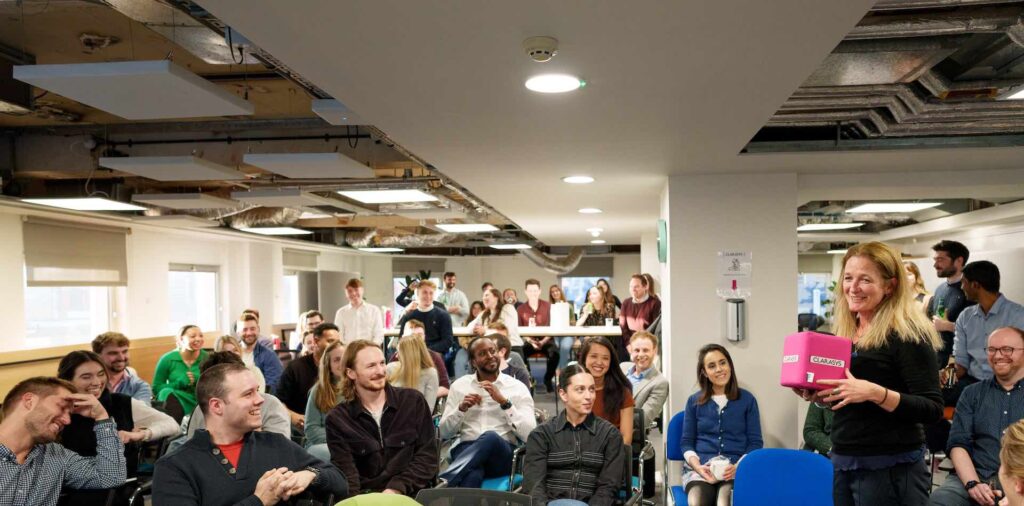In this post, we’ll explore the importance of creating a flexible and inclusive workplace in the hybrid era and where to start.
How to create an inclusive work environment in a hybrid workplace
How to create an inclusive work environment in a hybrid workplace
In this post, we’ll explore the importance of creating a flexible and inclusive workplace in the hybrid era and where to start.

Post-Covid, leaders are encouraging their teams to head back to the office, aiming to create an inclusive work environment. But have employees been as eager to return? Clarasys consultant Ana Sukhishvili looks at hybrid workplace best practices.
Pre-pandemic, employees were already showing a desire for flexibility at work. Fast forward a few years, and with enforced lockdowns in our rear view mirror, hybrid ways of working seem to be here to stay. But as leaders strive to create an inclusive workplace in a hybrid space, they face challenges in ensuring there are equal opportunities for everyone.
Hybrid models must transcend the physical workplace and include the diverse preferences and needs of employees, such as increased flexibility, improved work-life balance, and personalised experiences. This approach can greatly benefit diversity, equity, and inclusion (DE&I) initiatives, as well as overall performance. Achieving the right balance between hybrid work while fostering a robust sense of inclusion is essential. If we fall short on striking this balance, hybrid models can have unintended consequences, creating advantages for some groups while leaving others behind.
Starting the journey to a flexible and inclusive work environment
First of all, leaders must remember that implementing a flexible hybrid model needs consideration. It is an ongoing process that requires constant adjustment, sometimes to an individual level. For this, leaders need to actively listen, provide guidance, and most importantly, regularly track the way hybrid plays out for various groups within their organizations. This means understanding hybrid working patterns and prioritising employee wellbeing and flexibility. Building strong teams and enhancing team dynamics, together with collaborative respect for one another will also help.
Understanding hybrid working patterns
It is important to understand whether there are obvious hybrid working patterns within an organization. Many companies analyze pay, promotions, and attrition to ensure fairness among different demographic groups (e.g., age, race, gender). Hybrid work can also act as a variable that affects this equity. For instance, are parent employees more likely to request flexibility in working hours and location, while non-parent employees prefer to be office-based? Or, are the disparities role-based, where certain employees have the flexibility to choose their office days while others have a consistent and predetermined schedule?
To determine whether trends exist, we need to gather data on employees’ hybrid working preferences and understand how this varies across the demographics. Surveys, feedback platforms, and focus groups will help with this. If flexibility in hybrid models is unequally experienced by some demographic groups, we need to investigate whether factors such as gender, race, or other influence these differences.
Prioritising employee wellbeing and flexibility
At an organisational level, many employees would like policies that promote flexibility such as extended parental leave, sick leave, flexible hours, and work-from-home arrangements.
Managers who exemplify flexibility and support various work-life options, particularly in a hybrid model, will help to create a more inclusive work environment with a better work-life balance. Colleagues can also contribute to reinforcing this culture by validating acceptable behaviour. Encourage one another to utilize mental health benefits, leave policies, and other methods of establishing healthier boundaries between work and personal life.
Workplace culture can experience a profound transformation when colleagues share ideas and experiences of how they achieve a good work-life balance. This can be particularly valuable for newer colleagues.
Building strong teams and enhancing team dynamics
Building strong teams is the main priority of inclusion practices. In a hybrid workplace, a lack of team cohesion can lead to individuals feeling isolated. By getting to know your team well, understanding everyone’s strengths and weaknesses, and their personal and work pain points, the team will be more empathetic and collaborative, and play to each other’s strengths.
It’s also important to establish how the team can best work together. This can be particularly important when a new person joins. Consider having a meeting to introduce a new team member. Discuss how you work together, your roles, working styles, and preferences. A meeting like this pays dividends. Consider introducing a coaching and mentoring system, as well as a buddy scheme. All these activities should be embedded in the overall ways of working.
Fostering collaborative respect for an inclusive work environment
Mutual, collaborative respect is a key to creating an inclusive work environment, and it means displaying genuine concern for the wellbeing of all employees and a commitment to treating each other fairly and respectfully.
Strong connections with colleagues are harder to establish and miscommunication is more likely when there are fewer in-person interactions. In a hybrid working environment, therefore, we should experiment with meeting formats, determine when it’s beneficial to gather employees on-site, and check in with each other as much as possible. Create an environment where employees feel comfortable sharing personal updates, both positive and negative, and foster care and appreciation while individuals navigate the complex boundaries between work and personal life.
It might sound counter-productive, but celebrating mistakes is as important as praising success, because by learning from our mistakes, we can identify areas that need to be improved. Reframe these mistakes as opportunities for growth because a growth mindset will help to develop a team. At Clarasys, we embrace a culture of learning from our mistakes. In the past, we’ve shared stories like the time someone missed a flight because they were juggling too many tasks. The valuable lesson learned? It’s important to give yourself a break and avoid overstretching. When working with clients, we adopt an iterative and agile approach. Regular meetings allow us to openly discuss what worked and what didn’t. We believe in failing fast and trying again, always seeking continuous improvement.
On the flipside, celebrate success by fostering an environment that regularly recognizes standout moments. It is important to acknowledge achievements that are often overlooked by traditional reward and recognition systems. Organize team events and highlight people who provide coaching and support to their peers.
By implementing these suggestions, organizations can create a more connected and inclusive work environment in the hybrid era, nurturing mutual respect, continuous learning, and recognition of employee contributions.
To find out how we can help you with your hybrid working and employee experience strategy, please get in touch.

